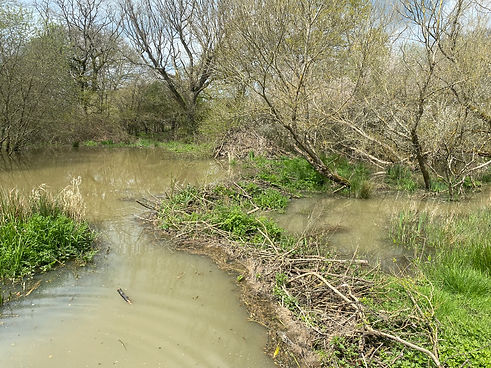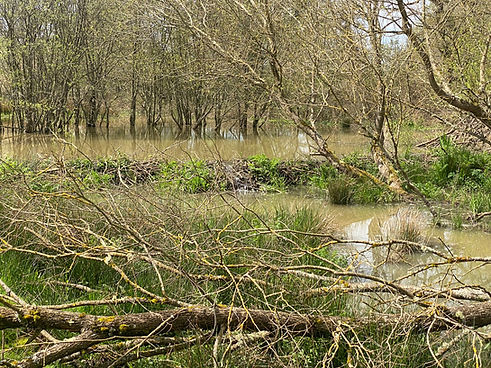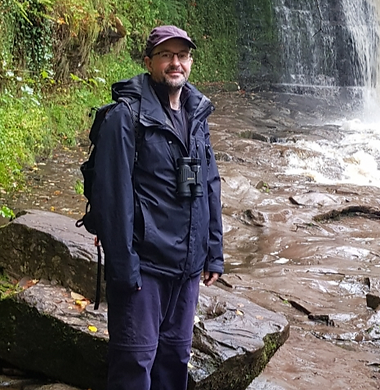
Beavers in Wiltshire
This page provides support and guidance for land managers including landowners, farmers, foresters and local communities in relation to beavers.
Whilst beavers in counties like Devon, Kent, and Scotland have rightly attracted attention, those in Wiltshire have quietly gone about their work, steadily colonising much of the county since arriving on local rivers in the 2000s. Today, beavers occupy much of the Bristol Avon catchment, are spreading through the Hampshire Avon catchment, and are also found in the Upper Thames/Cotswold Water Park.

Coexisting with beavers
People live alongside beavers throughout much of Europe and North America where communities have developed considerable knowledge for co-existing peacefully with beavers. In Britain, we now need to re-learn how to live alongside beavers. However, it is understood that along side the benefits which beavers can bring there may sometimes be conflicts with adjoining land uses. This page provides support and guidance to address potential issues.
The Beaver Management website was established by The Beaver Trust and Devon Wildlife Trust to support communities and land managers living alongside beavers, as well as to signpost people toward local sources of information.
Supporting Wiltshire's beavers
It is the intention to establish Beaver Management Groups (BMGs) in each catchment to provide advice and resources at a local level. BMGs have been established in counties/catchments such as Devon, Dorset, Cornwall, Bristol Avon and Somerset Frome, the Tamar, and East Kent.
However, a BMG is yet to be established in wider Wiltshire, covering the Hampshire Avon, Kennet and Thames catchments, leaving Wiltshire’s landowners without a local source of information or support to turn to.
These web pages are a direct response to this vacuum, providing a source of information, signposting to help and advice, and contact details for people to seek advice.
In time, If a BMGs are indeed established in the rest of Wiltshire, the webpages can provide additional signposting to those groups.

Meet the team
Introduction to beavers, ecology & history
Click here for the Beaver Trust Beaver biology poster.
Beavers are large semi-aquatic rodents, formerly widespread in Britain and Europe but hunted to extinction throughout much of their range, including Britain. Only the south American Capybara is larger in the rodent family. Beavers inhabit a range of wetland habitats, favouring slow-moving rivers, large lakes and complex wetlands.
Beavers are solely herbivorous, feeding on a range of woody and non-woody vegetation, from willow bark, through to irises, bulrush tubers and even ivy and rhododendron. They live in family groups of two adults and one or two generations of young, and they are very territorial. They breed in waterside burrows and/or lodges constructed of felled trees, mud and roots.
Beavers were hunted to extinction in Britain several centuries ago, although there is tantalising evidence of Beavers persisting in Britain until the 1700s. Beavers were hunted extensively for their pelts, but also for meat, for the anal scent glands (which contained salicylic acid, a painkiller, the active ingredient in aspirin), and for their body parts used as tools (e.g. their teeth and bones).
The Beaver Trust has compiled an excellent timeline of beaver events in Britain. Click here to read through.

Why beavers build dams
It is the intention to establish Beaver Management Groups (BMGs) in each catchment to provide advice and resources at a local level. BMGs have been established in counties/catchments such as Devon, Dorset, Cornwall, the county of Avon, the Tamar, and East Kent.
However, a BMG is yet to be established in Wiltshire, leaving Wiltshire’s landowners without a local source of information or support to turn to.
These web pages are a direct response to this vacuum, providing a source of information, signposting to help and advice, and contact details for people to seek advice. In time, these pages may become obsolete if and when BMGs are established in the county.

Wiltshire’s beavers: where did they come from?
To date, there have been no formal wild releases of Beaver in Wiltshire.
The first enclosed Beaver project in the county was in the Cotswold Water Park, at Lower Mill Estate (actually in Gloucestershire, but abutting the county boundary), and then on the By Brook in the 2000s. Both projects saw individuals escape. Beavers “escaped” from projects elsewhere in the Bristol Avon & Frome catchments more recently, establishing a widespread, and still growing, population in this catchment.
It appears that beavers dispersed naturally across the watershed from the Frome Catchment onto the river Wylye, and in recent years have established a population here. Beavers have been recorded elsewhere in the Hampshire Avon catchment, including on the Nadder, and on the Upper Avon near Pewsey. In low numbers Beavers can be remarkably unobtrusive and leave little evidence so it’s likely that others remain undetected at this time, as rumours of other locations are often heard and followed up. In 2024 we received reports of beavers on the Hampshire Avon downstream of Salisbury.
At this stage, there are no plans for further formal and licensed releases in Wiltshire, to our knowledge. Our priority at this time, is to monitor the expansion of existing populations and provide land management support and advice in areas with beavers
If you suspect you have beavers on your land, please get in touch and contribute this information to our wider knowledge of beavers in Wiltshire.

Legal protection, recent legislation relating to wild releases
As of 1st October 2022, the legislation was changed to protect wild-living beavers in England. They are now listed in Schedule 2 of the Conservation of Habitats and Species Regulations 2017, making it an offence to deliberately capture, injure, kill or disturb beavers, or damage and destroy their breeding sites or resting places without a wildlife management licence from Natural England.
This is the same legal protection that protects other species of conservation concern in Wiltshire including bats, Great crested newt, Water vole, Hazel dormouse and Otter.
This means that going forwards Beavers must be considered in built development proposals and river restoration proposals, likely requiring surveys and mitigation plans. We also suggest that beavers are also considered in other general land management too such as fencing on river banks, tree management and woodland creation.
Natural England has outlined a five-step approach to help landowners manage beaver activity on their land. Full details are available here. The process guides landowners through actions that don’t require a licence, followed by low and high-impact actions that do.
Non-licensable actions include protecting trees and crops, removing dam debris that poses a flood risk, and filling beaver channels that threaten banks, infrastructure, livestock, or machinery.
Guidance on licensable actions is available from those registered to use Natural England’s CL51 and CL52 class licences.
In February 2025, the UK government published a framework for permitted wild beaver releases in English waterways. This includes extensive requirements, such as 10-year project plans. In Wiltshire, this is unlikely to be relevant for now—beavers are already well established, and no local organisation currently has the resources to lead such a project.

Need for a strategic approach to beavers in Wiltshire
Whilst many counties and/or catchments have Beaver Management Groups and funded projects in place to offer guidance and support to landowners and farmers, Wiltshire is yet to be fully supported in this way, beyond the excellent work of the Bristol Avon & Somerset Frome BMG covering the Bristol Avon catchment. We’re concerned that this leaves Wiltshire’s landowners without a local source of information and support in relation to beavers.
We believe that beavers, their survey & monitoring, and their management, requires a strategic approach, whether at a county, catchment or sub-catchment level. Beavers will have a number of impacts, many positive, some negative, and landowners will need some support and advice. Going forwards, funds should be prioritised to awareness-raising and land management advice.
Impacts of beavers
“Analysis shows that the vast majority of human-beaver conflicts arise within 20m of the water’s edge. In Bavaria (Germany), over 90% of conflict with beaver occur within 10m of the water, while 95% occur within 20m. In Scotland, a study of beaver impact on woodland over a 4-year period found that the majority of beaver foraging occurred within 10m of the water.” Beaver Management website.

Impacts of beavers may include:
Foraging issues:
-
Felling of trees, especially “crop” or ornamental trees – apple, fruit trees, cricket bat willow
-
Crop damage – brassicas such as OSR and perhaps broccoli (but not relevant to Wiltshire, perhaps!)
Damming:
Not all territories will have dams, and beavers are unlikely to dam main rivers. Side channels and ditches are more likely.
-
Blockage of outfalls
-
Raised water levels.
Burrowing & digging:
-
Burrows may extend some distance from river, and collapse, damage tracks and fence lines
-
Wear and tear may lead to canals.
Mitigation & managing impacts
Beavers are powerful ecosystem engineers that primarily operate within 30 meters of freshwater bodies, often causing conflicts with human land use through damming, burrowing, and foraging. These activities can damage crops, trees, infrastructure, and riverbanks.
However, many effective solutions exist to mitigate their impact, including fencing, tree protection, dam modifications, and bank reinforcement. These interventions not only reduce risks but also offer ecological benefits like increased wetland creation, improved bank resilience, and restoration of natural processes. Some actions may require permits or landowner approval. The overall goal is to allow space for beavers and promote coexistence through habitat restoration and informed management.


When you need to manage beaver activities, you should work through these 5 solutions in order:
Only move onto the next solution if the one before has not resolved the situation.
-
Contact local beaver management groups and other experts for advice
-
Make space for beavers
-
Manage beavers with actions that do not require a licence
-
Manage beavers with lower impact actions that require a licence
-
Get help for higher impact actions that require a licence.
Each of the 5 steps are explained in more detail here.
For more information, visit Beaver Management here.
Grant support
There are a number of grants available to help support beaver management and conservation. This includes capital grant under Countryside Stewardship. For more information, please get in touch on Email.
Training events
The Beaver Trust, including training events such as mitigation. All upcoming training events can be found here.
Suggested reading
Eurasian Beaver Handbook – available from Pelagic Publishing or NHBS.
Beaver Class licences


